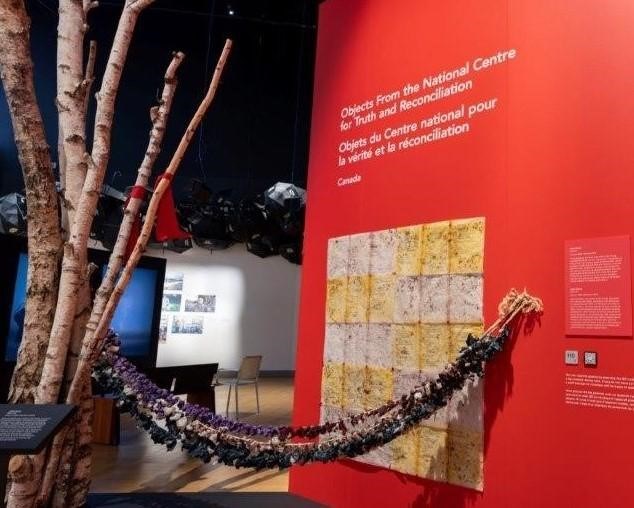WINNIPEG – As Canadians struggle with the discovery of unmarked graves of thousands of Indigenous children at residential school sites, a panel of international and Indigenous artists will share their experiences with art that sparks action against genocide.
Moderated by CBC journalist Duncan McCue, the discussion will draw on the work of artists featured in currently on display at the Canadian Museum for Human Rights (CMHR).
Artivism explores artistic expression as a powerful response to large鈥恠cale violations of human rights. It features the work of six artists and art collectives whose work takes an activist approach to expose, denounce and prevent mass atrocities. Artivism was developed by the for the Prevention of Genocide and Mass Atrocities, curated by Kerry Whigham, Francesca Giubilei and Luca Berta.
Witness Blanket: Preserving a Legacy explores a monumental art installation by Carey Newman, created with 800 objects collected from survivors and sites of Indian residential schools across Canada.
The virtual panel discussion about art in action against genocide will be held Tuesday, Sept. 28 at 1 p.m. live on Zoom Registration is free.
Panellists include:
Elisabeth Ida Mulyani, an Indonesian artist based in Belgium who created one of six installations for Artivism – including 13 golden ears, which symbolically address the 1965-66 disappearance and murder (often with ears kept as souvenirs) of at least half a million Indonesians purported to be communists by the Suharto military dictatorship. Mulyani’s work demonstrates the capacity of art to shine a light on past violence that states are not yet willing to recognize, and the residual effects still felt today.
Carey Newman (Hayalthkin’geme), a multi-disciplinary artist and master carver from Victoria with Kwakwak’awakw and Coast Salish roots. He is the creator of the Witness Blanket, a monumental art installation that calls on observers to bear witness to the atrocities of Indian residential schools and honour the children, who included his father. He is currently Impact Chair in Indigenous Art Practice at the University of Victoria.
Aida Šehovi膰, whose family fled Bosnia and Herzegovina, the artist behind the ŠTO TE NEMA “nomadic monument” consisting of 8,372 traditional Bosnian coffee cups arranged on forensic examiners’ racks. The cups memorialize the Bosnian Muslim men and boys who were killed or disappeared during the 1995 Srebrenica Genocide, when Bosnian Serb forces invaded a United Nations “safe area.” As part of ŠTO TE NEMA, passersby were invited to fill the little cups with coffee in memory of the victims, creating a tangible link to the impact and loss of genocide.
Kerry Whigham is the New York-based co-curator of Artivism and the director of Research and Online Education at the Auschwitz Institute for the Prevention of Genocide and Mass Atrocities. His research is focussed on ways that post-atrocity societies remember and engage with the past – and how a violent past affects present and future. He believes recovering from genocide is a process that an entire society goes through. Artivism was first displayed at the 2019 Venice Biennale.
Linda Young, paskwaw nehiyaw/Plains Cree from Onion Lake Cree Nation in Saskatchewan (Treaty 6 Territory), is a residential school survivor, artist, doctoral student and knowledge keeper. She contributed one of her artworks to the Truth and Reconciliation Commission of Canada. Consisting of medicine bags containing the shredded remains of her written story, tied to an empty baby swing affixed to a birch tree, it is now the central piece of a section of Artivism focused on genocide in Canada.





